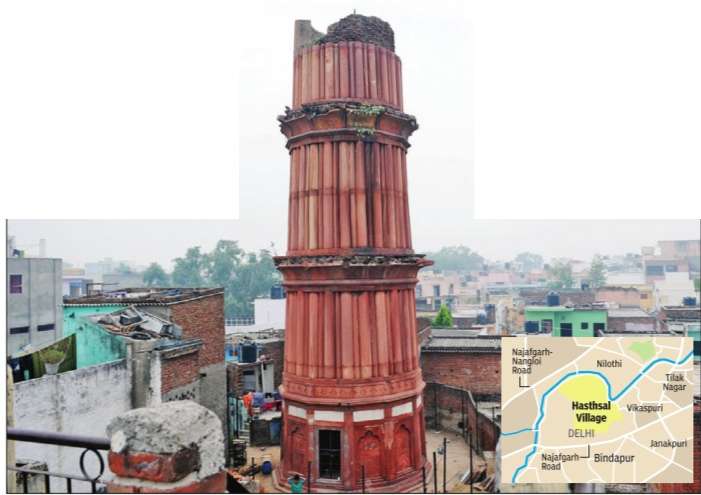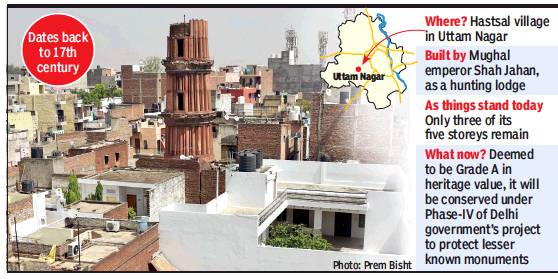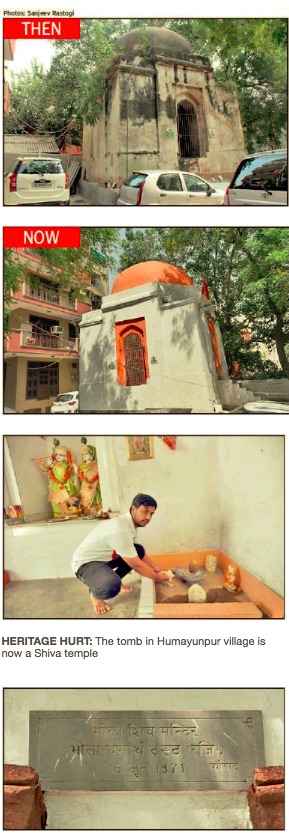Delhi: H
This is a collection of articles archived for the excellence of their content. |
Contents |
Hardayal Municipal Library, Chandni Chowk
The Times of India, Jun 13 2016, 15 Feb 2021

From: Vibha Sharma, September 1, 2019: The Times of India
See graphic :
The Hardayal Municipal Public Library: A brief history, 1862- 2019 '
Richi Verma
Vibha.Sharma@timesgroup.com
At 100, lifeline for city's oldest library
Hardayal Municipal Public Library was set up in 1862 when it was a part of Lawrence Institute, named after the then Viceroy of India. It currently has a collection of over 1.7 lakh books, of which 8,000 are rare manuscripts that need to be digitised.
The Hardayal Municipal Library had shifted to its present location at Chandni Chowk in 1916 with all its furniture. Now, its centenary bash would see a major conservation exercise to preserve the thousands of old and rare books.
Intach is spearheading this exercise. “The library houses one of the country's finest collections of antiquarian books, including gold illuminated translations of Hindu and Muslim religious works as well as a 1677 edition of Sir Walter Raleigh's History of the World. In all, there are over 8,000 rare books--potentially worth millions--from a stock of 1,70,000. The oldest book in the Library is A Relation of Some Years Travaile Beginning in 1626 by Thomas Hardy Esquire, published by Willaim Stansby and Jacob Bloome in 1634,“ said an official.
The conservation of books would be handled by Intach's material heritage division. The collection is at present stored in iron racks and almirahs, and preliminary visual examinations showed that the books were in a very deteriorated state and in urgent need of conservation. “There is no proper ventilation; humidity levels are very high; the place is musty and covered with dust and mildew. Micro-biological growth and termite and other insect infestation has damaged the collection,“ said an official.
Experts said that an understanding of why and how printed books and archival materials de teriorate would help understand the need for conservation. “The enemies of books and paper records, in addition to fire and water damage usually associated with disasters, are heat and humidity, light and ultra-violet energy, insects, rodents, fungi, oxygen, and acid,“ said an official.
Conservation would be preceded by a comprehensive survey and identification of items needing treatment, which would then be graded on the level of treatment required. Methods would be proposed later. The expert team would also give suggestions on storage and display . “The plan is to go for digitisation for as many books as possible, but there are some rare books which we might not be able to digitise if they are in a very fragile condition. The condition of each book would depend on whether it would be just preserved or digitised as well. This would be an extensive exercise,“ said a source.
The library would float a digitisation tender later this year. LG Najeeb Jung has already ap proved a Rs 3 crore grant to restore the library, which will be executed under DDA's Delhi Urban Heritage Foundation. “The Hardayal library is in urgent need of some intervention, and we have been asking the municipal bodies to do something for a long time. Finally, an MoU is going to be signed between Intach and DDA to preserve it. Intach would do the conservation work on the books and the building while DDA would fund it. The library belongs to everyone and needs to be protected for future generations.We have grand plans for celebrating hundred years in December this year and are planning an event involving heritage libraries all over the world,“ said library secretary Shobha Vijender.
2021: Reopened after renovation
Hasthsal Minar, Uttam Nagar
The Times of India, Aug 22 2015

Richi Verma
Shah Jahan's Qutub replica at risk of becoming history
For the residents of Hasthsal Village in Uttam Nagar, west Delhi, their minar is bigger than the Qutub. Local bias aside, Hasthsal Minar, built by Mughal Emperor Shah Jahan around 1650 AD, is a fairly impressive monument in its own right. It does not have the Qutub's superlative heft and height, nor the ornate balconies and calligraphic panels, but then it wasn't a victory tower meant to symbolize the emperor's might. Rather, it was a vantage point from which he could hunt wild animals on excursions out of his new capital, Shahjahanabad. Although now Hasthsal Minar has four storeys, conservationists say it had five when new and was topped by a domed chhatri just like the Qutub (the latter lost its chhatri in the earthquake of 1803). Both minars are faced with red sandstone, although the Qutub rises on thick walls of rubble and mortar while Hasthsal Minar has brick walls.
Both minars have spiral stairways leading to the top and doorways at each level. And like the Qutub's first level, the three upper levels of Hasthsal Minar are decorated with alternating angular and semi-circu lar `flutings'. For all these reasons, conservation body Intach assigns the minar archaeological value `A'.
Yet, this minar is now a picture of neglect. At 17 me tres high, it is only slightly taller than a four-storey building and in danger of being curtained off by the rising houses. Hemmed in from all sides, it can be reached only by a narrow lane past shacks and cattle sheds. Garbage and construction waste are piled up on its lower platform that has been completely taken over by the villagers. The upper platform, which is octagonal, is crumbling.
A gate that leads to the minar is kept locked but it's possible to reach the plinth and the lower platform from any of the new houses. The new constructions on the plinth have also weakened the structure and experts say they should be removed at the earliest. Large cracks are visible on the sandstone façade.
“A chowkidar comes sometimes to clean the site, otherwise, no one is allowed inside the minar,“ said a local resident. Kavita, another resident, said, “Three generations of my fam ily have lived here and seen the monument gradually squeezed in by new constructions. Most of us know it is a very old building but have no clue about who built it and its importance.“
Shah Jahan's hunting lodge nearby has not fared much better. It was part of a much larger enclosure that's discernible only in parts now.
The minar figures on Delhi government's list of 250 unprotected monuments that need to be conserved, but it wasn't taken up in the first two phases of the project.Sources said it might be skipped in the third phase also and not get any attention before next year.
Shah Jehan's hunting lodge
Richi Verma, A Qutub Minar that not many knew even existed, June 19, 2018: The Times of India

From: Richi Verma, A Qutub Minar that not many knew even existed, June 19, 2018: The Times of India
Intach, Delhi Govt Have Now Taken It Under Their Care
It is called the Mini Qutub Minar, but this 17th century minaret in a village in west Delhi has neither been protected nor promoted for its archaeological value. In fact, if one were to visit the relic in Hasthsal village in Uttam Nagar, you would find it accessible only via a grimy, half-metre-wide lane surrounded on all sides by frenzied construction activity. Though late to wake up to the need to conserve it, the Delhi chapter of Intach and Delhi government’s archaeology department have fortunately decided to take it under their care.
The tower, built by Mughal emperor Shah Jahan as part of his hunting lodge, today only has three of its five storeys remaining. It is architecturally similar to the more feted 13th century monument in south Delhi, but unlike the Qutub Minar, which has World Heritage Site status, the replica in Hasthsal is in dire conditions.
Deemed to be Grade A in heritage value, the Mini Qutub Minar will be conserved under Phase IV of Delhi government’s project to protect lesser known monuments in the capital. Officials disclosed that they have carried out an assessment of the site and conservation work will begin shortly.
“Our primary focus will be to consolidate the structure because we are concerned that the foundation of the minar may have been weakened by decades of neglect,” said an official. The project also entails conservation of the facade and preservation of the unique carvings on the mini tower.
The stonework — the neglected minar is made of brick masonry cladded with red sandstone — will be chemically cleaned in a painstaking procedure and any gaps between the stones will be filled in. However, recreation of the missing portions of the monument, such as the upper storeys, is not part of the agenda. Conservations explained that missing portions of historical monuments are usually not recreated unless there are archival materials and firm evidence of the original structure. In addition to these, the small courtyard that surrounds the minar will be given an improved look.
Conservationists explained that the Qutub Minar lookalike originally had five storeys and was topped by a domed chhatri. The upper two storeys and the chhatri are believed to have collapsed in the 18th century. While the lower platform has been encroached upon by villagers, the other octagonal platform is in a dilapidated condition and the steps leading up to it disappeared a long time ago.
Hauz Qazi
Mubarak Begum mosque
Mohammad Zahid, the muezzin, was in his room at 6.45am on Sunday when he heard a loud noise “as if the sky had fallen”. He rushed to the courtyard and was aghast to see that the 19th century iconic mosque of Mubarak Begum had lost its central dome.
“It must have been lightning because rain, no matter how strong, cannot do this to the 200-year-old mosque that is repaired periodically. The rubble was scattered across the courtyard, suggesting the dome broke with a lot of force,” said Zahid, who has been the muezzin since 2004.
Despite this, prayers took place as hundreds turned up to see the destruction. But there was a time when the mosque was boycotted and hardly anyone prayed there. Historian Rana Safvi said it was one of the few structures in Delhi that was built by a woman. Referred to as a “courtesan’s mosque”, the structure stands in the middle of Hauz Qazi Chowk, a stone’s throw from Chawri Bazaar metro station. The mosque was given the name due to its association with Mubarak Begum. While not much is known about her, it is said that she was one of the wives of Sir David Ochterlony, the first British resident of Delhi, and that she was a tawaif (courtesan) from Pune who, perhaps, converted to Islam.
According to ASI, the mosque doesn’t come within its purview. Sabir Ansari, a member of the mosque’s committee, said, “The mosque’s repair must be done soon to preserve its heritage value .” He added that it is maintained by Delhi Waqf Board.
Himal Akhtar, a member of the waqf board, told TOI, “We will send our engineers and architects to assess the damage and soon initiate repairs.”
However, a resident of Old Delhi, Abu Sufyan, expressed worry that the repairs could lead to the structure being rebuilt in a modern design. “The mosque might lose its heritage value,” he added. Intach convener Swapna Liddle said, “It’s important to conserve old monuments using original materials.”
Hospitals, health
See Healthcare and public health: Delhi
Humayunpur
Tughlaq-era tomb turned into a temple: 2018
From tomb to temple: Tale of monumental neglect, May 5, 2018: The Times of India

From: From tomb to temple: Tale of monumental neglect, May 5, 2018: The Times of India
Probe Ordered, FIR Soon To Take Back Tughlaq-Era Building
Humayunpur village is in ferment. The residents of this urban village near Safdarjung Enclave, who always considered the Tughlaq-era tomb in the heart of the locality as a temple, recently painted it white and saffron. They also underlined the building’s official status as a temple by placing idols of Krishna and Radha in it. The fact that this building is actually a listed heritage building and a 15th century tomb has had no relevance to the villagers. That is why reclaiming the monument from the community is going to be a difficult task for the state archaeology department. Delhi government, it is learnt, plans to lodge an FIR and take back the monument as part of its conservation plans for the city’s unprotected monuments.
A statement from deputy chief minister Manish Sisodia on Friday said, “Causing damage and harm to a heritage property is against the law and a serious offence. It is the duty of the state archaeology department to ensure the protection of heritage monuments listed under it and take strict actions in case of a lapse. The reported incident should be handled with zero tolerance by the department as it not only violates heritage related laws but is also an attempt to disturb peace and harmony in the area.”
The minister added that the secretary of the art, culture and language department has been asked to provide him with a detailed report by Saturday, along with details of the case and the action taken.
A dusty plaque outside the arched structure defines it as a Shiv Bhola temple since June 15, 1971. “This building has always been a temple. As a child, I used to come here regularly with my mother and have been seeing the villagers worshipping here. Only the statues of Radha and Krishan are recent additions,” claimed septuagenarian Chaudhary Prem Raj, a resident. Villagers admit to making the external changes a few months ago but it was done in order to “protect the building”.
“The building was in a poor shape and the village wanted to do something,” explained Amit, another resident. “Money came through donations, and with the help of our area councillor we got the two statues installed in the structure. Work was also done on the exteriors as well.” The villagers collected about Rs 35,000 for the two-ft-tall statues. People say the building already had a Shiv Ling.
Radhika Abrol Phogat, the South Delhi Municipal Corporation councillor for Safdarjung Enclave, however, denied any involvement in the issue. “In the five years I have lived here, I never knew the temple was a heritage structure,” Phogat said. “The local people got it painted recently, and I have nothing to do with it. I am being targeted for no reason.”
The structure has tiles with pictures of Hindu gods on the external walls near the gate. Housewives Reshama and Aarti told TOI that aarti was performed twice every day in the morning and evening at the ‘temple’. Others claimed it had a dedicated priest who came in twice a day, but TOI was unable to verify this. “The ‘temple’ is opened only for aarti services. It is kept locked at other time due to the threat of vandalism,” said Amit.
According to the list of heritage buildings compiled by Zafar Hasan in the 1912, the structure is a tomb of an unknown person. “The building is used as a fodder store by villagers and its doorways are filled in with earth and rubble,” reads the description from the 1920s. Sometime later, it appears that the building began to be used as a temple.
Intach Delhi chapter had listed the structure as an unprotected monument in 2016. “It was included in Phase III of the conservation plan, but we could not start work because our teams always found the monument under lock and key,” said an Intach official. “We reported the matter to the archaeology department, which contacted the cops.”